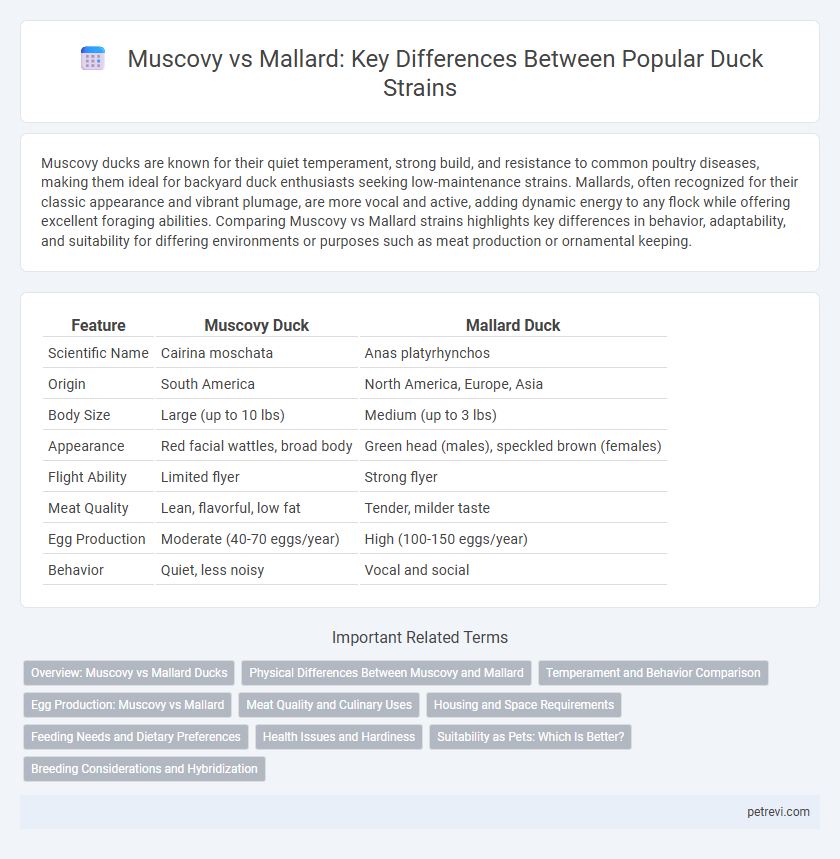Muscovy ducks are known for their quiet temperament, strong build, and resistance to common poultry diseases, making them ideal for backyard duck enthusiasts seeking low-maintenance strains. Mallards, often recognized for their classic appearance and vibrant plumage, are more vocal and active, adding dynamic energy to any flock while offering excellent foraging abilities. Comparing Muscovy vs Mallard strains highlights key differences in behavior, adaptability, and suitability for differing environments or purposes such as meat production or ornamental keeping.
Table of Comparison
| Feature | Muscovy Duck | Mallard Duck |
|---|---|---|
| Scientific Name | Cairina moschata | Anas platyrhynchos |
| Origin | South America | North America, Europe, Asia |
| Body Size | Large (up to 10 lbs) | Medium (up to 3 lbs) |
| Appearance | Red facial wattles, broad body | Green head (males), speckled brown (females) |
| Flight Ability | Limited flyer | Strong flyer |
| Meat Quality | Lean, flavorful, low fat | Tender, milder taste |
| Egg Production | Moderate (40-70 eggs/year) | High (100-150 eggs/year) |
| Behavior | Quiet, less noisy | Vocal and social |
Overview: Muscovy vs Mallard Ducks
Muscovy ducks (Cairina moschata) are larger, heavier birds known for their unique red facial caruncles and quieter behavior, often preferred for meat production due to their leaner, less fatty meat. Mallard ducks (Anas platyrhynchos) are smaller, more widespread wild ducks recognized for their iridescent green heads in males and higher vocal activity, commonly used for ornamental purposes and wildfowl hunting. Both strains differ significantly in habitat adaptability and breeding patterns, with Muscovies thriving in warmer climates and Mallards exhibiting migratory behaviors.
Physical Differences Between Muscovy and Mallard
Muscovy ducks exhibit a more robust body with a unique caruncle, a red, warty facial skin, unlike the smooth-faced Mallard. The Mallard features a sleek, iridescent plumage with a distinctive green head in males, whereas Muscovies have less vibrant but more varied colors, often in white, black, or spotted patterns. Muscovy ducks generally have longer legs and a more pronounced tail curl compared to the Mallard's compact build and classic tail shape.
Temperament and Behavior Comparison
Muscovy ducks exhibit a calmer temperament, often displaying less aggression and a more reserved nature compared to Mallard ducks, which are typically more lively and social. Muscovies tend to be quieter and less vocal, favoring solitary or small group behavior, whereas Mallards are more active, easily startled, and frequently engage in group foraging and swimming. This behavioral contrast makes Muscovy ducks preferable for smaller or quieter environments, while Mallards thrive in active, communal settings.
Egg Production: Muscovy vs Mallard
Muscovy ducks produce larger eggs with an average size of 70-100 grams compared to Mallard ducks, which lay smaller eggs averaging 40-50 grams. While Muscovies lay fewer eggs annually, typically around 60 to 120, Mallards can lay approximately 80 to 150 eggs per year. The Muscovy's eggs have thicker shells, making them more resistant to breakage, an important factor in egg production efficiency.
Meat Quality and Culinary Uses
Muscovy ducks offer leaner, less fatty meat with a richer, redder flesh compared to Mallards, making them prized for robust, gamey flavor in gourmet dishes. Mallard-derived duck strains feature tender, mildly flavored meat with higher fat content, suitable for roasting and confit preparations that require juicy, succulent texture. Culinary applications favor Muscovy meat for grills and stews demanding bold taste, while Mallard strains excel in classic recipes emphasizing tenderness and subtle flavor profiles.
Housing and Space Requirements
Muscovy ducks require more spacious and secure housing due to their larger size and territorial behavior, with at least 4 square feet per bird recommended indoors and 15 square feet in outdoor pens. Mallard ducks, being smaller and more social, thrive comfortably in slightly more compact housing, needing about 3 square feet per bird inside and 10 square feet in outdoor runs. Both strains benefit from dry, well-ventilated shelters with ample access to water and nesting areas to promote health and productivity.
Feeding Needs and Dietary Preferences
Muscovy ducks require a diet higher in protein, around 18-20%, to support their slower growth and leaner muscle development compared to Mallards, which thrive on a more balanced diet with moderate protein levels near 16-18%. Mallards prefer a varied diet including aquatic plants, insects, and grains, reflecting their natural foraging habits, while Muscovies favor a diet richer in greens and insects due to their innate grazing behavior. Both strains benefit from supplemental feeding during molting and breeding seasons to meet increased nutritional demands.
Health Issues and Hardiness
Muscovy ducks exhibit greater resistance to common poultry diseases and adapt well to diverse environmental conditions, making them hardier than Mallard strains. Mallard ducks, while more susceptible to respiratory infections and parasites, thrive in wetland habitats but require more attentive health management. The Muscovy's robust immune system and tolerance to heat and cold stress enhance their survivability compared to the more delicate Mallard strain.
Suitability as Pets: Which Is Better?
Muscovy ducks are often better suited as pets due to their quieter nature and less aggressive behavior compared to Mallard ducks, which can be more vocal and territorial. Muscovies also require less maintenance as they have a natural resistance to parasites and do not need water to maintain their feathers as often as Mallards. For families seeking a low-maintenance, calm pet duck, Muscovy ducks offer superior compatibility.
Breeding Considerations and Hybridization
Muscovy ducks exhibit strong disease resistance and grow larger, making them ideal for meat production, while Mallard ducks are favored for their rapid growth and adaptability in various environments. Crossbreeding these two strains results in hybrids known as "Mule ducks," combining the Muscovy's size with the Mallard's fertility and vigor, often leading to improved hybrid vigor and growth rates. Breeders must consider the sterility of male Mule ducks and the fertility of females when planning for optimal reproduction and flock management.
Muscovy vs Mallard for Duck Strains Infographic

 petrevi.com
petrevi.com